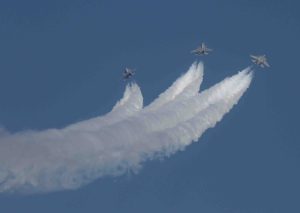On February 10, India’s Defense Minister Rajnath Singh inaugurated a five-day defense systems exhibition in the country’s information technology capital, Bengaluru. Aero India 2025, as this ongoing biennial exhibition is called, is the 15th edition of what New Delhi touts as Asia’s biggest aerospace and defense exhibition. Participating this year are 900 exhibitors from 90 countries, including 100 original equipment manufacturers (OEMs). Defense ministers from over 30 countries are attending, either virtually or in person.
India, the world’s biggest spender in the international arms bazaar, is easily able to draw in the world’s biggest arms sellers. According to the Stockholm International Peace Research Institute (SIPRI)’s most recent report, India was the world’s top arms importer over the five-year period 2019-23, with imports rising by 4.7 percent compared to the 2014-18 period.
While the United States remains India’s premier arms supplier, France has slipped smoothly into second place. The manufacture in India of six Scorpene submarines, the purchase of 36 Rafale fighters, and the upgrade of 50 Mirage 2000 fighters have resulted in France supplanting Russia as India’s second-biggest weapons supplier. Even so, Moscow retains its stranglehold over large sections of India’s weapons imports, including T-90S tanks and armored personnel carriers, S-400 integrated air defense systems, Krivak III-class frigates, and Akula-class nuclear-powered submarines.
Now every major aerospace OEM is positioning itself to win the biggest prize in the international combat aircraft market: the Indian Air Force (IAF)’s ongoing acquisition of 114 medium fighters.
Most aerospace OEMs have already signaled their interest. The United States and Russia have sent their latest fifth-generation fighter aircraft to Bengaluru. The Pentagon is showcasing the F-35 Lightning II, the world’s most widely deployed fifth-generation fighter. The presence of the F-35 is a statement by itself.
Competing in the skies with the U.S. Air Force’s flagship will be the Russian Air Force’s latest fighter — the Sukhoi-57. Aviation buffs in Bengaluru are lining up in droves to enjoy the high-speed aerial maneuvers that highlight both fighters’ power and agility.
A dark cloud over these festivities is posed by a troubling question: To what extent can India’s modest treasury pay for these expensive weapons of war? An examination of budgets over the last decade makes it clear that New Delhi can afford only a modest arsenal. The most recent annual budget, presented on February 1, allocated only 6,812 billion rupees ($78.4 billion) for defense expenditure over the coming year. That amounts to 13.45 percent of central government expenditure (CGE) and a similarly modest 1.91 percent of Gross Domestic Product (GDP). This conforms with New Delhi’s practice since 2020–21. Since then, India’s defense allocations have languished below 14 percent of CGE and around 2 percent of GDP.
This leaves a limited amount for force modernization to face a formidable “two-and-a-half front threat”: two fronts from the combined forces of Pakistan and China, India’s two implacable foes, who act in concert against India, with another half front consisting of insurgencies in Jammu and Kashmir and the northeastern states of India.
Meanwhile, trackers of defense spending, such as The Military Balance, report that China has raised its annual defense budget by 7 percent to about $235 billion — three times India’s most recent defense allocation of $78.4 billion. China now accounts for 44 percent of Asia’s total defense spending. The People’s Liberation Army (PLA) is spending heavily on advancements in defense technologies, ensuring the emergence of new capabilities. New aircraft designs are breaking cover even as the fifth-generation J-20 multirole aircraft grows its profile inexorably. The PLA’s third aircraft carrier, the Fujian, has reportedly commenced sea trials and a fourth carrier is believed to be under construction. Two new long-range fire-support brigades have been formed.
The government of India, however, which is grappling with competing priorities in the social development fields of education, healthcare, and infrastructure building, confronts serious limitations on what it can spend on weaponry. India’s defense spending of 6,812 billion rupees is greater than its combined spending on rural development (2,668 billion rupees), urban development (967.77 billion rupees), healthcare (983.11 billion rupees), education (1,286 billion rupees), and energy (811.74 billion rupees).
Consequently, despite the daunting security challenges from China and Pakistan, New Delhi has chosen the difficult path of going it alone in weapons development. Unlike a decade ago, India’s defense production establishment can point to numerous success stories. Advanced platforms like the Tejas light fighter, Prachand light attack helicopter, India’s ballistic and tactical missiles that support its nuclear deterrent, the 155 mm advanced towed artillery gun, Pinaka multi-barrel rocket launcher, and the Indo-Russian BrahMos cruise missile increasingly feature in war plans.
Defense Minister Rajnath Singh, while inaugurating Aero India 2025, expressed confidence that India’s annual defense production, currently standing at 1,270 billion rupees, would exceed 1,600 billion rupees by the end of 2025-26. Meanwhile, defense exports, currently standing at 210 billion rupees, would surpass 300 billion rupees.
For this, Prime Minister Narendra Modi is relying heavily on his fledgling defense industrial base. But, how far the policy of “Aatmanirbharta” (self-reliance) can carry India remains to be seen.

































